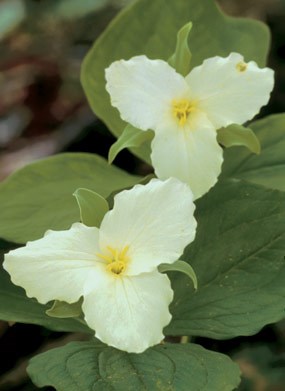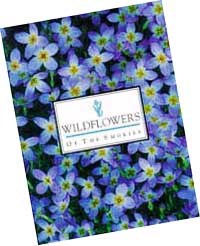
A group of flowers known as spring ephemerals begins the yearly show. Ephemerals are so named because they appear above ground only in late winter and early spring, then flower, fruit, and die back within a short two month period. They emerge from February through April, and are gone (dormant) by May or June. This remarkable group of plants is adapted to the rhythm of the overstory trees. Ephemerals appear before deciduous trees leaf out, when full sunlight is streaming to the forest floor. This is also a time when soil moisture is high and soil nutrients are plentiful due to the decomposition of tree leaves that fell the previous autumn. The ephemerals exploit these conditions—they flower, fruit, and their above-ground parts decay before summer gets into full swing. The peak of spring wildflower blooming usually occurs in mid- to late-April at lower elevations in the park, and a few weeks later on the highest peaks. Spring ephemerals include flowers such as trillium (the park has 10 different species), lady slipper orchids, showy orchis, crested dwarf iris, fire pink, columbine, bleeding heart, phacelia, jack-in-the-pulpit, little brown jugs, and violets, to name just a few. Suggested wildflower hikes. Each spring, the park hosts the Spring Wildflower Pilgrimage, a week-long festival of programs and guided walks and hikes that explore the wondrous diversity of life in the park. By late summer and through the fall, goldenrod, wide-leaved sunflowers, tall ironweed, mountain gentian, monk’s hood, coneflowers, and numerous varieties of asters begin to bloom. Purple umbels of sweet Joe-Pye-weed stretch towards the sky and can reach heights of ten feet. Trees and shrubs bloom throughout the year too. From February through April the flowers of red maples paint the mountains with a wash of brilliant red. Showy trees such as serviceberry, silverbell, flowering dogwood, redbud, Fraser magnolia, and tuliptree soon follow. Later in summer sourwood, a tree prized for the honey that bees produce from its small bell-shaped, white flowers, begins to bloom. The year ends with the yellow flowers of witch-hazel, which blooms from October through January. Learn about the threats facing wildflowers and how you can do your part to protect them.
Recommended Reading 
Wildflowers of the Smokies |
Last updated: March 26, 2025
